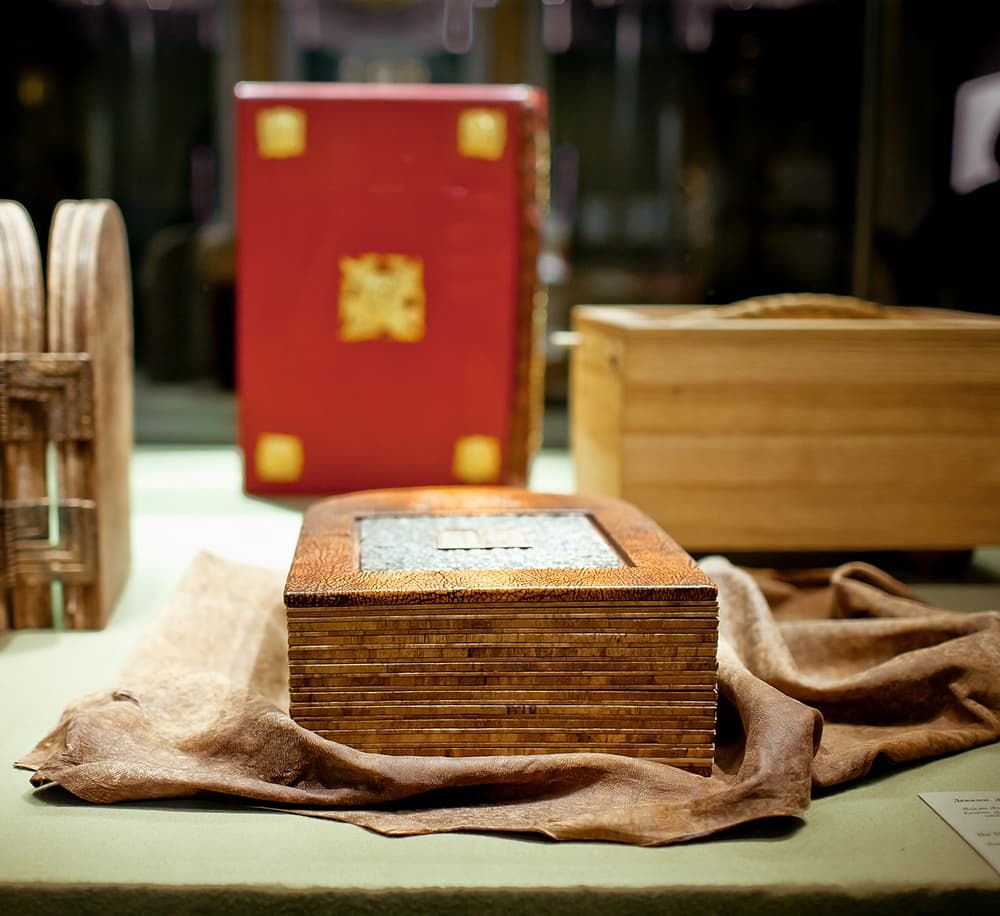THE TEN COMMANDMENTS
Deuteronomy 5:6–21
It is hard to call this publication a book in the traditional sense of the word. The unusual cover design, the materials used, and the impressive size of the oak case make it more of an objet d’art, an exquisite creation, a unique museum exhibit.
Additional information
Details of the creation of this masterpiece
-
Year of publication:2008
-
Number of pages:21 sheets
-
Dimensions:book — 370 × 245 × 135 mm; case — 420 × 310 × 270 mm
-
Paper:papyrus (Egypt); paper pulp (reliefs in the form of matzoth); parchment (Israel)
The Ten Commandments (Decalogue) are a collection of legislative injunctions that, according to the Bible, were handed down by God on Mount Sinai in the third month after the Jewish people’s exodus from Egypt. The publishing house brought out its first edition of the Decalogue (Exodus 20:2–17) with a print-run of 25 copies in 2005.
In 2006 the book was accorded its own individual exhibition in the State Hermitage. In 2008 the first copy of a second edition of the Ten Commandments came out. This was like an echo of the twofold revelation of the words of the Law. Originally the Lord revealed the Ten Commandments on two stone tablets, the Tablets of the Law (or Covenant), given to Moses on Mount Sinai. When Moses came down from the mountain carrying the tablets and saw the Israelites worshipping the golden calf, he smashed them in anger. After the people repented, by God’s mercy and at His behest Moses carved new tablets on which the Lord again revealed His Ten Commandments. Those tablets were then placed in the Ark of the Covenant.
The uniqueness of the new edition lay not just in the original materials used to make it – leather, silver, stone, papyrus, parchment, oak and jute, in other words practically everything that humanity has used throughout history to create books – but also in the choice of artistic method that reflected historic events filled with sacred meaning.

Concept and design of the book, type layouts in Ancient Hebrew, hand colouring of the paper reliefs imitating matzoth — Mikhail Kopylkov
Type layouts (apart from Ancient Hebrew), setting of the title page, translations and colophon — Yevgeny Bolshakov
Creation of a version of the Prague Haggadah typeface — Mikhail Kopylkov, Andrei Lurye,
Anna Kogan
Printing of the text on parchment — Sergei Yashin
Embossing, printing on leather and papyrus — Andrei Degtev, Andrei Kulikov
Making matzo-like reliefs from paper pulp — Andrei Lurye
Designing and making the compound hinge, making the matzo-like silver relief for the cover, the moulds for the paper-pulp matzo-like reliefs, assembly of the book — Valentin Belenky
Making the tablets of the Law on the cover (stone-carving work) — Boris Kachalov
Making the case — the firm OOO Delovye Sistemy (Saint Petersburg)
Technical assistance — Victor Davydov
Scholarly consultants for the work on the translations of the Ten Commandments by language:
Ancient Hebrew — Semion Yakerson
Church Slavonic — Sergei Makov
Russian — Anna Savelyeva
English — Ivan Popov
German — Yelena Glotova
French — Alexei Sergeyev
Italian — Alexander Korolev
Spanish — Natalia Suslova
The text of the Commandments was printed by hand on the matzoth using a vintage 19th-century Dingler press and a specially created modern-day version of the Hebrew typeface used in the Prague Haggadah printed in that city in 1526.
Translations printed on sheets of extremely fine parchment imported from Israel are inserted between the boards of the book. Parchment is a writing material produced from untanned processed animal skin that was used before the introduction of paper. In Judaism parchment is the canonical material to be used for the revelations on Mount Sinai in manuscript scrolls of the Torah. Only the skins of kosher animals can be used for writing sacred scrolls.
The boards making up the book are joined together by an elaborate hinge of unique design that was made in patinated sterling silver. It is intended to allow people not so much to leaf through the book as to “throw it open” like the doors or gates of wisdom. The hinge is made up of twelve (the number of Tribes of Israel) separate leaves with shapes that resemble the square Hebrew script and seem to form the letters making up the name of God – יהוה (the Tetragrammaton) and 26 (a sacred number in the cabbalistic tradition, the number of Yahweh) knuckles
.
The book is wrapped in a piece of sheep leather in keeping with the traditions for storing and transporting books followed by the peoples of the Ancient Middle East. The case for the book symbolizes the Ark of the Covenant and is made of oak with a jute rope handle.
The total weight of all the sterling silver elements of each book is 2.1 kilos (4 lb 10 oz). The total weigh of the book in its case is around 15 kilos.
Additional information
Details of the creation of this masterpiece
-
Year of publication:2008
-
Number of pages:21 sheets
-
Dimensions:book — 370 × 245 × 135 mm; case — 420 × 310 × 270 mm
-
Paper:papyrus (Egypt); paper pulp (reliefs in the form of matzoth); parchment (Israel)
The Ten Commandments (Decalogue) are a collection of legislative injunctions that, according to the Bible, were handed down by God on Mount Sinai in the third month after the Jewish people’s exodus from Egypt. The publishing house brought out its first edition of the Decalogue (Exodus 20:2–17) with a print-run of 25 copies in 2005.
In 2006 the book was accorded its own individual exhibition in the State Hermitage. In 2008 the first copy of a second edition of the Ten Commandments came out. This was like an echo of the twofold revelation of the words of the Law. Originally the Lord revealed the Ten Commandments on two stone tablets, the Tablets of the Law (or Covenant), given to Moses on Mount Sinai. When Moses came down from the mountain carrying the tablets and saw the Israelites worshipping the golden calf, he smashed them in anger. After the people repented, by God’s mercy and at His behest Moses carved new tablets on which the Lord again revealed His Ten Commandments. Those tablets were then placed in the Ark of the Covenant.
The uniqueness of the new edition lay not just in the original materials used to make it – leather, silver, stone, papyrus, parchment, oak and jute, in other words practically everything that humanity has used throughout history to create books – but also in the choice of artistic method that reflected historic events filled with sacred meaning.

Concept and design of the book, type layouts in Ancient Hebrew, hand colouring of the paper reliefs imitating matzoth — Mikhail Kopylkov
Type layouts (apart from Ancient Hebrew), setting of the title page, translations and colophon — Yevgeny Bolshakov
Creation of a version of the Prague Haggadah typeface — Mikhail Kopylkov, Andrei Lurye,
Anna Kogan
Printing of the text on parchment — Sergei Yashin
Embossing, printing on leather and papyrus — Andrei Degtev, Andrei Kulikov
Making matzo-like reliefs from paper pulp — Andrei Lurye
Designing and making the compound hinge, making the matzo-like silver relief for the cover, the moulds for the paper-pulp matzo-like reliefs, assembly of the book — Valentin Belenky
Making the tablets of the Law on the cover (stone-carving work) — Boris Kachalov
Making the case — the firm OOO Delovye Sistemy (Saint Petersburg)
Technical assistance — Victor Davydov
Scholarly consultants for the work on the translations of the Ten Commandments by language:
Ancient Hebrew — Semion Yakerson
Church Slavonic — Sergei Makov
Russian — Anna Savelyeva
English — Ivan Popov
German — Yelena Glotova
French — Alexei Sergeyev
Italian — Alexander Korolev
Spanish — Natalia Suslova
The text of the Commandments was printed by hand on the matzoth using a vintage 19th-century Dingler press and a specially created modern-day version of the Hebrew typeface used in the Prague Haggadah printed in that city in 1526.
Translations printed on sheets of extremely fine parchment imported from Israel are inserted between the boards of the book. Parchment is a writing material produced from untanned processed animal skin that was used before the introduction of paper. In Judaism parchment is the canonical material to be used for the revelations on Mount Sinai in manuscript scrolls of the Torah. Only the skins of kosher animals can be used for writing sacred scrolls.
The boards making up the book are joined together by an elaborate hinge of unique design that was made in patinated sterling silver. It is intended to allow people not so much to leaf through the book as to “throw it open” like the doors or gates of wisdom. The hinge is made up of twelve (the number of Tribes of Israel) separate leaves with shapes that resemble the square Hebrew script and seem to form the letters making up the name of God – יהוה (the Tetragrammaton) and 26 (a sacred number in the cabbalistic tradition, the number of Yahweh) knuckles
.
The book is wrapped in a piece of sheep leather in keeping with the traditions for storing and transporting books followed by the peoples of the Ancient Middle East. The case for the book symbolizes the Ark of the Covenant and is made of oak with a jute rope handle.
The total weight of all the sterling silver elements of each book is 2.1 kilos (4 lb 10 oz). The total weigh of the book in its case is around 15 kilos.
THE TEN COMMANDMENTS
Deuteronomy 5:6–21
The second edition of one of the most extraordinary books of publishing house
Download video presentation




